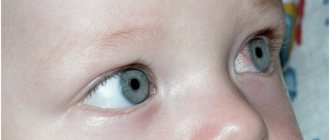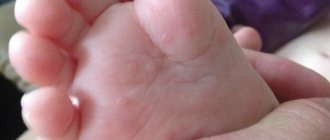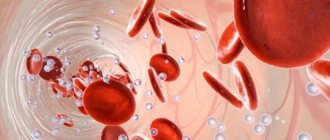Breast milk and infant formula contain a large amount of useful substances: fats, proteins, enzymes, carbohydrates, vitamins, minerals. An important component of milk is lactose, a carbohydrate necessary for the growth and development of bacteria with enzymatic activity in the baby’s intestines. Anaerobic bacteria perform an important function: they eliminate allergens, destroy toxins, suppress the growth of pathogenic and putrefactive microbes, promote the absorption of calcium and the digestion of organic substances.
But breast milk can cause anxiety and distress in the baby due to lactose (milk sugar) intolerance.
Description and characteristics
Lactose is considered the main carbohydrate found in milk and dairy products.
Lactose consists of glucose and galactose .
When lactose is broken down, it releases a special enzyme called lactase.
And if this lactase itself is not enough, then this will be the root cause of lactose intolerance.
This condition may be due to a genetic factor. Quite often this disorder is diagnosed in babies born prematurely. Low birth weight newborns are also more susceptible to the disease.
But older children may also develop secondary lactose intolerance, which appears in connection with another disease.
Causes of lactose allergy
When cow's milk protein enters a child's body, the immune system begins to produce IgE antibodies. Each subsequent meal stimulates the production of mediators - inflammatory cells. They are often histamine, which can cause diarrhea and severe discomfort in the baby’s tummy. In addition to this, the skin looks inflamed, with numerous rashes.
Allergies in infants on the face
The occurrence of allergies begins immediately after the first contact with cow's milk proteins. They can be part of infant formula, which is forced to replace mother's milk. Parents need to understand that the child will react not only to cow's milk, but also to goat's milk. Therefore, the latter cannot be considered as a substitute; even 1 g of milk protein is contraindicated for a baby. Nutritionists recommend that children not be fed milk from cloven-hoofed animals.
A reaction to lactose is more common in infants than other types of allergies. The explanation of experts is the early addition of cow's milk to the diet of babies at an early age. According to various sources of statistics, from 0.5% to 3% of children from 0 to 3 years old are faced with the problem of allergy to milk protein.
The baby’s body reacts strongly to individual components of lactose: casein (up to 80%), whey components (20%). As the baby gets older, the usually severe allergy symptoms disappear or significantly decrease. After three years of age and older, the problem is less common.
The problem occurs when there is insufficient production of the enzyme (lactase) to break down milk sugar. In normal mode, without problems with intolerance, milk sugar is broken down into glucose and galactose. They are absorbed into the blood through the intestinal walls. When the amount of enzyme is low, lactose enters the large intestine unchanged. Subsequently, undigested milk protein, interacting with bacteria, provokes signs of intolerance.
Pediatricians identify the causes of deficiency or absence of the lactase enzyme, which causes lactose intolerance:
- Congenital. Determined by predisposition at the genetic level. The gene mutation appears from the first hours of life.
- Secondary. The influence of environmental factors, including diseases of the mucous membranes of the small intestine.
Attention! Milk protein intolerance is not as dangerous as a lactose allergy. There is a risk of anaphylactic shock from the body's reaction to the irritant.
What provokes it?
There are a number of clearly identified provoking factors that can lead to this diagnosis. As already mentioned, this is a genetic predisposition - the disease tends to be inherited.
Reasons for NL:
- ethnicity;
- premature birth;
- heredity;
- pathologies associated with the small intestine, where lactose is broken down and synthesized.
The causes of secondary lactose intolerance are intestinal infections , inflammation in the intestines, allergies to cow protein, and celiac disease.
How to recognize?
How does lactose intolerance manifest in infants?
In children, the nature of their stool may indicate illness. It is distinguished by a pronounced sourish unpleasant odor and watery state.
The disease is also indicated by frequent and severe regurgitation, flatulence, diarrhea, whims during feeding, refusal to eat, be it breast milk or formula.
Older children lag behind in weight gain, grow poorly, have decreased muscle tone and even have seizures. Flatulence and stomach rumbling in older children can also indicate an illness. Sometimes the child experiences umbilical pain .
Recommendations for the treatment of intestinal malabsorption syndrome in children can be found on our website.
Diagnosis of the condition
To begin treatment for your baby, it is necessary to determine the type of lactase deficiency and understand the reasons for its manifestation. To diagnose lactose intolerance, a number of laboratory tests are prescribed:
- 1. Genetic test - a group of MCM6 proteins is analyzed, the presence of C13910T is detected - a genetic marker that affects the susceptibility to changes in lactase secretion.
- 2. Intestinal biopsy is a procedure for obtaining living tissue cells for microscopic examination. Using this method, the most accurate diagnosis is established. But for infants, a biopsy is prescribed only as a last resort due to the possibility of damage to the intestinal walls and bleeding.
- 3. Test for blood sugar levels (glycemic curve) - the baby is given a liquid with milk sugar to drink and blood is taken for analysis 4 times within two hours. Lactose is not digested unless the amount of glucose in the blood increases.
- 4. Blood test to construct a lactose curve - blood is taken from a fingertip on an empty stomach, in the morning. Then the baby is given lactose and blood is drawn several times over the course of one hour to determine the amount of milk sugar in the blood. Based on the obtained readings, a curve is built that is compared with the glycemic curve. Then the doctor draws conclusions about lactose intolerance. It is difficult to carry out such a test on an infant, and the accuracy of the diagnosis is low.
- 5. Hydrogen test - the device is used to determine the amount of hydrogen in the air exhaled by the baby after he has taken lactose. The test is performed on children from three months of age. There are no generally accepted norms for the level of this gas in infants.
- 6. Stool analysis - shows the concentration of carbohydrates in the stool. Material for research is collected after the natural process of emptying into a sterile cup in a minimal amount (1 teaspoon). Within 3-4 hours after collection, the stool must be delivered to the laboratory. If the carbohydrate content in stool significantly exceeds 0.25%, the doctor suspects lactase deficiency in the infant. The method is one of the cheapest and simplest, but it gives a lot of false information and should be considered together with other tests. Coprogram - determines the presence of substances in stool and its acidity. If the lactase enzyme is insufficient, the amount of fatty acids in the baby’s stool increases, the stool environment becomes acidic, and the pH value decreases to 4.0 pH.
Often, to clarify the diagnosis, a scraping is taken from the cheek mucosa in children: at least two hours before the material is collected, the baby is not allowed to eat or drink. If test results show abnormalities, but symptoms of insufficient enzyme production are not observed, the doctor will not prescribe treatment.
Types of Enzyme Deficiencies
In the first four months of life, children often experience lactose intolerance due to the immaturity of the endocrine, immune, nervous systems, and gastrointestinal tract organs.
There are several types of lactase deficiency in newborns:
- 1. Congenital (primary) – it is caused by a genetic disorder in the production of lactase (inherited from parents). There is no treatment. With the help of medications and diet, doctors can only stabilize the baby’s condition.
- 2. Acquired (secondary) - occurs as a result of diseases of internal organs, inflammatory processes, allergies to gluten, cow's milk. Often the cause is immaturity of enzymes and dysbacteriosis. In this case, you should not deprive the baby of natural feeding and completely switch to lactose-free formulas. Digestive problems disappear by 4–6 months.
- 3. Transient - manifests itself in premature infants due to an immature digestive system. After 12-16 weeks, the activity of enzyme production will be restored and the painful manifestations will disappear.
If lactase is absent, the baby is diagnosed with alactasia. And if a small amount of the enzyme is detected, hypolactasia is diagnosed. In both cases, the healthy carbohydrate lactose is not absorbed by the body.
Symptoms of intolerance
Signs of lactose intolerance vary in intensity, duration and depend on the following reasons:
In the first weeks of a child's life, signs of the disease do not appear. Over time, the symptoms worsen and become more obvious. Whatever the causes of lactase deficiency, the following adverse effects are observed:
A child with normal enzyme activity may develop symptoms of hypolactasia. The condition is caused by an excess of lactose in milk when the baby receives breastfeeding “foremilk”, which contains a lot of milk sugar.
Symptoms and signs
How can you tell if your newborn baby is lactose intolerant?
A set of signs that appear from the gastrointestinal tract system will let the parent know that something is going wrong. And if these signs are systemic, then most likely it is lactose intolerance.
Symptoms of the disease:
- stool is often, a lot, the stool is watery with a sour smell; when tested for acidity, this indicator will be increased.
- Flatulence - increased bloating and gas formation leads to colic, which makes the baby restless, but this often indicates other physiological processes in the body.
- Regurgitation - almost immediately after feeding, the baby regurgitates breast milk or formula; if regurgitation is infrequent and minor, this is the norm, but constant ones should be studied.
- The child's behavior - he refuses to eat, almost immediately after feeding the baby begins to cry.
Remember that one way or another, such phenomena can occur in all healthy babies. But if the phenomena are constant, this should alarm the parents - show the baby to the pediatrician.
Problems of babies during breastfeeding and methods of dealing with them
Babies do not always tolerate breastfeeding well, since milk, along with substances beneficial to their body, may also contain allergens that cause health problems.
The reason for this may be poor nutrition of the mother and weakness of the baby’s gastrointestinal tract. It has not yet had time to fully develop and cannot fully cope with all the substances that enter it. It is also worth remembering that the microflora of babies is sterile; only over time, beneficial bacteria appear in it, which will be responsible for the normal digestion of food.
For colic
Special nutrition is indicated for mothers with colic in newborns. To understand what exactly causes bloating, you need to analyze what new foods you have introduced into your diet over the past 2 weeks and eliminate their use for a while.
A diet for a nursing mother with colic in a child should definitely be used, this will help make life easier for the baby and the mother in labor.
The following products will have to be excluded from the menu during the diet:
- fresh kefir, but you can drink the one that was made 2 days ago;
- fresh vegetables and fruits, only boiled, steamed or baked;
- all carbonated drinks;
- packaged juices;
- whole milk;
- chocolate;
- cocoa;
- legumes;
- cabbage in any form.
For lactose deficiency
If a baby is lactose intolerant, breast milk intolerance may occur. Lactose is a special enzyme produced in our body. It is responsible for the normal absorption of milk sugar - lactose. By nature, humans have normal lactose tolerance, but it may be that the baby cannot fully cope with it.
A lactose-free diet for a woman with breastfeeding involves a complete abstinence from whole milk and some (or all) fermented milk products. Most often, such measures are temporary and after 2 weeks you can begin to try to gradually introduce foods that contain lactose into the diet.
Sometimes a dairy-free diet continues throughout breastfeeding; this happens in cases of congenital lactose intolerance, which is extremely rare in practice.
Doctors recommend using the following measures for lactose intolerance in a child:
- When feeding, allow one breast to be completely emptied at once and only then apply the baby to the other.
- Reduce the amount of foods with allergens in your diet, especially cow's milk.
- Do not express milk after feeding, since hind milk is the fattest and most beneficial for the baby.
- Express foremilk (approximately 30 g), which is high in carbohydrates, before feeding.
For constipation
A nursing mother should also have a special nutrition system if her baby is constipated. There are products that have a strengthening effect, and there are, on the contrary, those that have a laxative effect. If a child has problems with bowel movements, then you need to include in your diet something that will help him improve digestion.
Mom needs to eat the following foods during the day:
- dried apricots and prunes, can be soaked in water;
- fresh apricots, but no more than 15 pieces per day;
- boiled beets;
- kefir, 1-2 days old, preheated;
- sliced baked pumpkin with fresh apples;
- clean water without gas.
For allergies
Mothers who have children with allergies should approach the choice of products very carefully and responsibly. For atopic dermatitis of an infant, nursing women are prescribed a hypoallergenic diet, from which foods that cause a negative reaction in the child are completely excluded. However, this does not mean that you and your baby will eat only 2-3 dishes for the rest of your life.
It often happens that an allergy manifests itself not to one product, but to a combination of them. You should carefully monitor the baby's condition after each feeding, so you can find out what kind of food he does not tolerate well.
The most common highly allergenic foods:
- Carbohydrates: chocolate, cocoa, cakes, butter bread, gingerbread, pastries, ice cream, halva, honey.
- Fish and seafood: seafood - all, fish - canned and fatty varieties, caviar.
- Meat: goose, pork, lamb, veal, chicken, duck, smoked meats.
- Berries: strawberries, sea buckthorn, raspberries, strawberries, grapes, cherries.
- Fruits: peaches, apricots, melons, citruses, persimmons, pomegranates, red apples, dried fruits, compotes and canned fruits, all tropical fruits.
- Vegetables: pumpkin, rutabaga, tomatoes, radishes, eggplants, carrots, sorrel, beets, sweet red and yellow peppers, sunflower seeds.
- Cereals: semolina, Artek cereal, wheat cereal.”
- Dairy and fermented milk products: sharp cheese, processed cheese, baby curds, milk, fermented baked milk, yogurt, cream, sour cream.
A balanced diet during breastfeeding is the key to the proper development of the baby and the health of the mother, so you should not neglect it even if the child does not have any problems. Try to choose fresh and high-quality products for your menu, prepare simple but tasty food that will bring you pleasure.
Diagnostics and tests
Lactose intolerance can also be diagnosed based on clinical manifestations.
But if the doctor has doubts, additional tests will be ordered.
Diet diagnostics are very often used - products that contain lactose are excluded from the child’s diet.
Then they look at the clinical manifestations and do a stool analysis . If the symptoms have decreased, the pH level is normal or higher, therefore, the baby is lactose intolerant.
Signs of lactase deficiency
Understanding that a baby is lactose intolerant is not that difficult. But symptoms indicating digestive problems do not always indicate low lactase production. Most of them are quite natural for infancy and individually have nothing to do with the disease under discussion.
Often the symptoms of one disease are disguised as the symptoms of another
Here are some signs that are common in young children, but do not always mean that the baby is lactose intolerant:
- Intestinal colic . Almost all “healthy” children go through the colic stage, so on their own they have a right to exist. After 2-3 months, colic disappears, regardless of whether the woman stops breastfeeding or not. So there is no direct connection with the disease.
- Frequent stools resembling diarrhea . The baby eats liquid, easily digestible food. Therefore, it is normal if he poops frequently, the consistency is liquid, the color varies from mustard yellow to greenish, and there may be undigested milk lumps and a little mucus in the stool. In a newborn, such stool is not considered diarrhea, and certainly does not indicate problems with digestion.
- False constipation . Infrequent bowel movements, provided that the stool is soft and the baby does not strain or blush during bowel movements, is quite acceptable. Breastfed babies may poop once every 2-3 days.
- Regurgitation. They arise mainly due to dysfunction of the valve between the stomach and esophagus. Infrequent regurgitation is not considered a pathology and is not treated in any way.
- Restless behavior during or after feeding . Digestion and breakdown of lactose begins about 20-30 minutes after feeding, so breast refusal or restless behavior cannot be affected in any way. Most likely, the baby’s moodiness is associated with irritation of the esophagus or stomach, but that’s another story.
Sometimes the only solution for children with lactase deficiency is to stop drinking whole milk.
What can be concluded? Taken together, the listed symptoms may indicate a suspicion of lactase deficiency, but they must be considered as a whole. In addition, lactase deficiency is not an autonomous disease. It is only a consequence of other pathologies. Therefore, other signs may indirectly indicate lactose intolerance:
- allergic skin rashes;
- slow weight and height gain, developmental delays;
- iron deficiency anemia that cannot be treated;
- stools are too frequent (more than 9 times a day), watery;
- true constipation with dense feces and difficult evacuation.
How dangerous is the pathology?
If the pathology is primary, then it will remain forever. can still consume some amount of milk .
And signs of this disease will begin to appear if you increase the norms of dairy products for your child.
Secondary intolerance has no consequences . Time will pass, and the baby’s body will begin to react normally to milk again. It is believed that six months or a little longer is enough for the disease to go away completely.
What does it mean to have Klebsiella in a baby’s stool? Find out the answer right now.
Manifestations of lactose allergy
Diarrhea in infants while breastfeeding
In general, the child’s body’s reaction to an irritant, which is cow’s milk protein (CMP), is part of a food allergy. Most often, the baby is bothered by problems with the digestive tract:
- stomach upset;
- gagging;
- constipation;
- reflux (reflux of bile).
The baby’s behavior changes, he gets tired quickly and has trouble falling asleep, and is more capricious than usual. In the current situation, it is difficult to recognize the true cause of the malaise. If you are allergic to lactose, symptoms on the skin of infants appear in the form of hives or eczema.
Skin rashes can easily be confused with prickly heat or seborrheic dermatitis. Unlike the atopic type, the reaction of manifested dermatitis during allergies is localized in the area:
- baby's cheeks;
- dimples under the knees;
- elbow bends.
Sometimes the allergy spreads to the baby's torso, causing him anxiety from itching and irritation. First, the skin loses moisture and becomes dry. A complicated form of lactose allergy is characterized by the appearance of numerous weeping and crusts on the skin.
Allergic reaction
Important! You shouldn’t be scared; you need to evaluate the baby’s condition as a whole. The sooner the correct diagnosis is made, the faster the pediatrician will select a diet for feeding. As a result, all manifestations may gradually disappear.
Treatment methods
If the pathology is secondary, the doctor will focus on treating the underlying disease.
The child will be prescribed a special diet. When remission occurs, the list of products gradually expands. The clinical picture of the disease is constantly monitored, and all necessary tests are carried out.
If intolerance is primary, children are prescribed a diet that requires constant adherence. But don’t worry, this diet does not cause any serious inconvenience.
Children who are already one year old are advised to replace milk with products low in lactose, or simply with fermented milk products.
Confectionery products containing dairy are also excluded.
What to feed the baby?
A child who has reached the age of transition to a common table can eat yogurt with live bacteria, as well as soy milk and cheese instead of dairy products. Since milk contains a lot of calcium, which is so important for a growing child’s body, it is necessary to replace the product with something alternative.
It can be:
- tuna (canned), salmon and sardines;
- kale, broccoli;
- cereals;
- soy products;
- almond nut
At the doctor's insistence, the child can be prescribed special medications .
These can be “Lactase-baby”, “Linex”, and also “Hilak-forte”.
Pancreatin can be prescribed additionally as an enzyme that improves digestion .
What does Komarovsky say?
The famous pediatrician Evgeny Komarovsky notes that true lactose intolerance does not appear as often as it is detected .
impossible to completely give up products with lactose in the first months of a baby’s life . He notes that refusing breast milk is unacceptable, and it is definitely more harmful than consuming it.
The doctor also says that the consequences of improper feeding are often mistaken for illness. For example, the baby receives only so-called foremilk, which is not as nutritious, but rich in carbohydrates and lactose.
But hind milk contains all the components for saturation and digestion of fore milk.
Therefore, proper feeding, which can be helped by a lactation specialist, can relieve symptoms that are similar to signs of lactose intolerance.
Mixtures
Since lactose is still necessary for the body as a source of energy , and this is especially important for a growing organism, it is absolutely impossible to do without it in the nutrition of a newborn. Therefore, for a baby with lactase deficiency on artificial feeding, there are three options:
- Feeding a regular milk formula with a normal lactose content plus helping the child’s body break it down. How can you help? Preparations with the lactase enzyme, which you can read about in detail here, are an indispensable medicine in the fight against this disease.
Since the child’s body itself cannot completely break down lactose into its important components - galactose and glucose, due to inadequate production of the lactase enzyme in the intestines, an additional amount of lactase introduced into the body “artificially” helps in this.
Read about how to properly add enzyme to the mixture here.
- Feeding with lactose-free and regular formula in proportions . That is, the baby’s diet contains regular infant formula made with milk, with the addition of lactose-free or low-lactose formula. Why is this necessary? If you mix a regular and lactose-free formula, then the amount of food (the formula that the child eats at one feeding) remains the same, what is needed, and the amount of lactose in it will be less .
How to make such a mixture correctly? The dosage of each mixture in feeding can be prescribed by a pediatrician, or the mother herself can see how the baby behaves after feeding, how he reacts to “mixed” nutrition and draw conclusions about the correct dosage.
It is recommended to start with a proportion of ½. For example, 40 ml of lactose-free or low-lactose mixture per 80 ml of regular milk mixture. This diet can be maintained for a week, after which pediatricians recommend taking a stool test for carbohydrates to see how the body absorbs the reduced amount of lactose.
If the analysis shows that the baby’s intestines still “pass” undigested milk, and therefore lactase, you need to further think about changing the proportions of food and reducing lactase in it. For example, set the proportion to 1/1 (60 ml of both mixtures) and so on.
- Feeding a low-lactose mixture . So-called lactose-free mixtures contain a minimal amount of lactose - approximately 0.1 g per 1 liter of mixture. Low lactose - no more than 10 g per 1 liter of mixture.
What types of low-lactose mixtures are there:
- Infants from birth to two months : with malt extract.
- Infants from two months to six months : with flour.
- Infants from six months : low-lactose baby milk.











